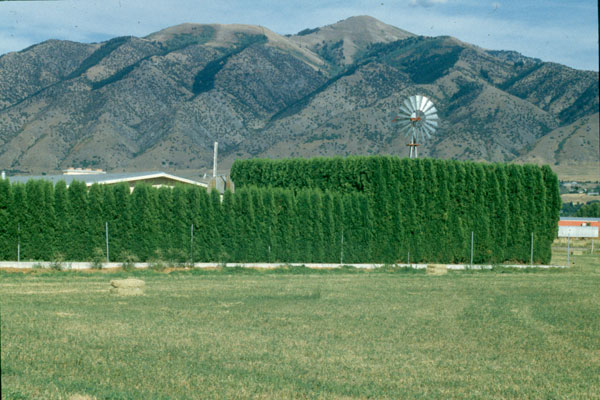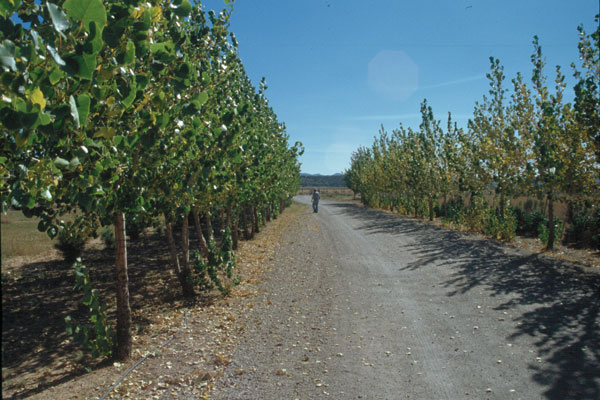Modern Windbreaks Fight Drought
by Michael Kuhns, Extension Forestry Specialist
Windbreaks can be very effective in reducing crop water use and water evaporation from the soil surface. They also may be the only method to protect soil from wind erosion when little crop residue is available due to drought. Most farmers and ranchers, however, are living with windbreaks that are old-fashioned, outdated, and ineffective. Others have removed windbreaks because they are in the way or are considered unnecessary.
In most situations, windbreak designs of the past are no longer sensible. In the 1930's many windbreaks were planted 10 to 20 rows deep, requiring a lot of land. It was thought at the time that these large tree plantings would modify the climate of the Great Plains, not only near the windbreak, but regionally. Greater rainfall was predicted as a result. This large scale climate change as a result of tree planting never occurred.
The large windbreaks of the 30's did and still do serve a useful purpose, however. Fields, farmsteads, and livestock were protected from the harsh winds of the Plains. Such large windbreaks were also good for wildlife, particularly deer and pheasants. Many of these large windbreaks are still around, serving these same functions.

Unfortunately, these large windbreaks were not entirely beneficial. People began to feel that a proper windbreak needed to be 10 to 20 rows deep to be effective. It seemed reasonable that a deep windbreak would protect more land more effectively from wind. People also knew, however, that these large windbreaks took a lot of land out of production. Old windbreaks that could be up to a mile or more long also got in the way of center-pivot irrigation systems and large farm machinery.
These perceptions eventually led people to believe that windbreaks did not fit with modern farming systems. The need for windbreaks was gone anyway, since the Dust Bowl years were over and crop yields were good. Many field windbreaks were removed over the past three decades because of these attitudes.
Modern windbreaks do have a place on todays farms and ranches. New windbreak designs, such as twin-row high-density plantings, are much narrower, requiring less land, and yet are more effective than the old designs. In a twin-row high-density windbreak two evergreen rows, normally redcedar or juniper, are planted close together with a tree in one row filling a gap in the next row. This design fills in and becomes effective very quickly after planting.
Single-row windbreaks, similar to the "hedge" or osage-orange windbreaks formerly planted in some parts of the U.S., can also be used where space is limited. These can consist of an evergreen row to give protection year-around, a single shrub row, or a densely-branched deciduous tree can be used. Even though a deciduous tree loses its leaves in winter, it can still provide good crop protection during the growing season. It can also provide considerable wind protection and can control snow distribution in winter. Proper initial tree spacing and maintenance are very important in single-row windbreaks. Gaps cannot be allowed since there are no trees in adjacent rows to fill them.
Shallow windbreaks from one to three rows deep are more effective at protecting land than old, deep, and very dense windbreaks. Windbreaks with many rows and high density allow very little wind through. This creates a low pressure zone just downwind that draws the air stream above the windbreak down to the ground. Therefore, even though these windbreaks may give very good protection just downwind, their protection zone is short
Modern windbreaks are shallower and less dense, letting enough wind through that a low pressure area does not develop. Their protection zone extends much farther down wind as a result.
Regardless of whether shrubs or tall trees are used in a well-designed windbreak, its protection will extend 12 to 15 times its height downwind. A 10 foot-high shrub windbreak will therefore protect 120 to 150 feet downwind before another windbreak is needed. A tree windbreak with a mature height of 40 feet will protect 480 to 600 feet downwind. Windbreaks should therefore be placed about 12 to 15 times their mature height apart for complete protection. Figure 1 shows an example of a single-row windbreak system that can protect a field using only 5% of the available land.

Another modern windbreak idea is to use shrub windbreaks to protect center-pivot irrigated fields. Shrubs are used that grow low enough for the pivot to walk right over. Though this idea has seen limited use, it could potentially be of much value where center pivots are used on soils subject to wind erosion and with high-value crops.
In addition to their benefits in reducing wind erosion and controlling snow, windbreaks can increase crop yields. Research has shown average yield increases due to wind protection of 15% in winter wheat, 25% on soybeans, and 12% on corn. Other crops have shown similar yield increases. Quality of many specialty crops can also be improved by reduction of abrasion and fruit rub behind windbreaks. Figure 2 shows the general effect of a windbreak on crop yields and various environmental factors within a field.
For more information on design and planting of modern windbreaks, contact your NRCS office, District Forester, or Extension Agent.

